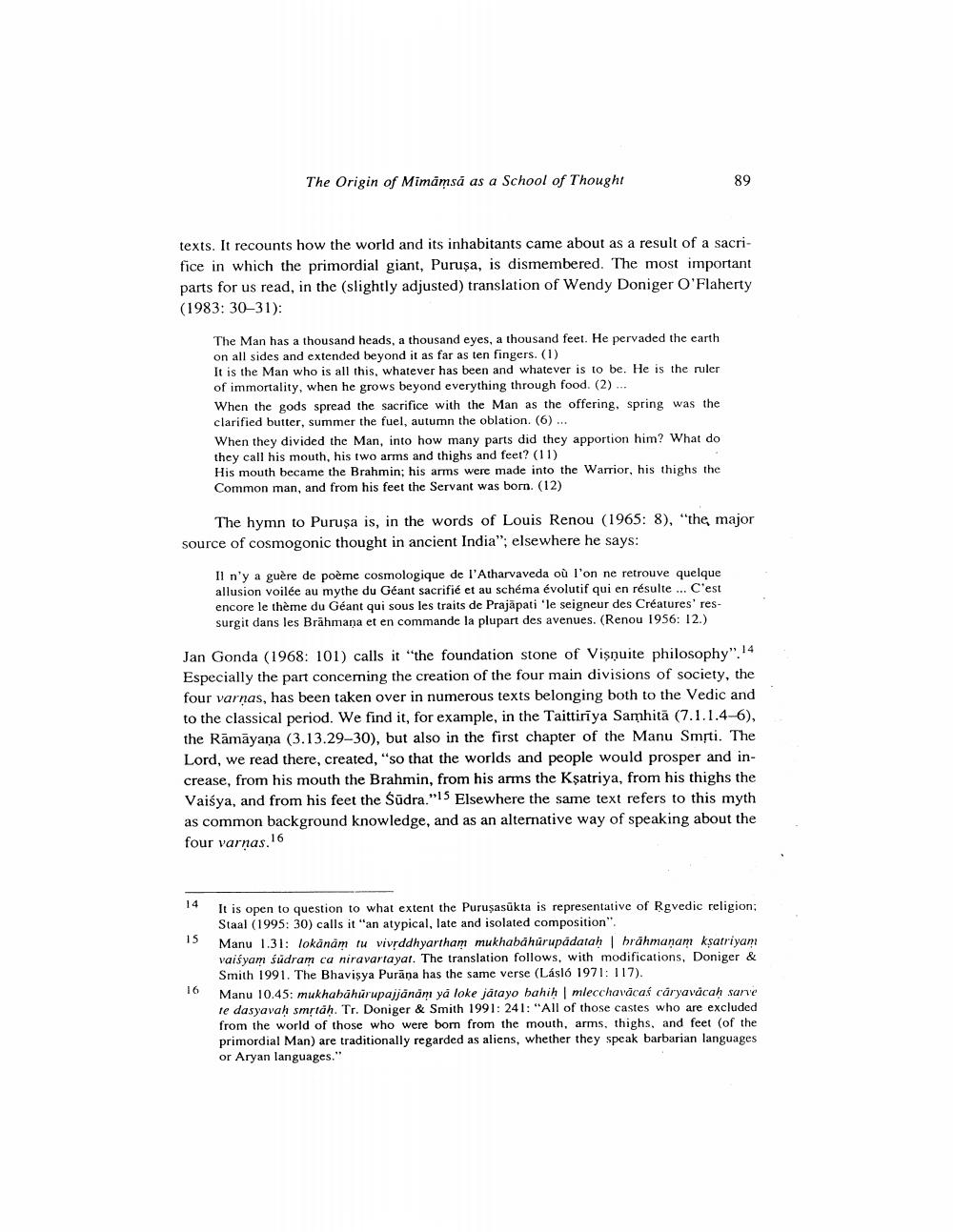Book Title: Origin Of Mimamsa As A School Of Thought A Hypothesis Author(s): Johannes Bronkhorst Publisher: Johannes Bronkhorst View full book textPage 7
________________ texts. It recounts how the world and its inhabitants came about as a result of a sacrifice in which the primordial giant, Puruşa, is dismembered. The most important parts for us read, in the (slightly adjusted) translation of Wendy Doniger O'Flaherty (1983: 30-31): The Origin of Mimämsă as a School of Thought 14 15 The Man has a thousand heads, a thousand eyes, a thousand feet. He pervaded the earth on all sides and extended beyond it as far as ten fingers. (1) It is the Man who is all this, whatever has been and whatever is to be. He is the ruler of immortality, when he grows beyond everything through food. (2)... 16 When the gods spread the sacrifice with the Man as the offering, spring was the clarified butter, summer the fuel, autumn the oblation. (6) .... The hymn to Puruşa is, in the words of Louis Renou (1965: 8), "the, major source of cosmogonic thought in ancient India"; elsewhere he says: When they divided the Man, into how many parts did they apportion him? What do they call his mouth, his two arms and thighs and feet? (11) His mouth became the Brahmin; his arms were made into the Warrior, his thighs the Common man, and from his feet the Servant was born. (12) 89 Jan Gonda (1968: 101) calls it "the foundation stone of Vişnuite philosophy".14 Especially the part concerning the creation of the four main divisions of society, the four varnas, has been taken over in numerous texts belonging both to the Vedic and to the classical period. We find it, for example, in the Taittiriya Samhita (7.1.1.4-6), the Rāmāyaṇa (3.13.29-30), but also in the first chapter of the Manu Smrti. The Lord, we read there, created, "so that the worlds and people would prosper and increase, from his mouth the Brahmin, from his arms the Ksatriya, from his thighs the Vaisya, and from his feet the Śūdra."15 Elsewhere the same text refers to this myth as common background knowledge, and as an alternative way of speaking about the four varnas.16 Il n'y a guère de poème cosmologique de l'Atharvaveda où l'on ne retrouve quelque allusion voilée au mythe du Géant sacrifié et au schéma évolutif qui en résulte ... C'est encore le thème du Géant qui sous les traits de Prajapati 'le seigneur des Créatures' ressurgit dans les Brāhmaṇa et en commande la plupart des avenues. (Renou 1956: 12.) It is open to question to what extent the Purusasukta is representative of Rgvedic religion; Staal (1995: 30) calls it "an atypical, late and isolated composition". Manu 1.31: lokänäm tu vivṛddhyartham mukhabähürupadataḥ | brāhmaṇam ksatriyam vaisyam sudram ca niravartayat. The translation follows, with modifications, Doniger & Smith 1991. The Bhavisya Purana has the same verse (Lásló 1971: 117). Manu 10.45: mukhahāhurupajjänäm ya loke jätayo bahiḥ | mlecchavacas caryavācaḥ sarve te dasyavaḥ smṛtäh. Tr. Doniger & Smith 1991: 241: "All of those castes who are excluded from the world of those who were born from the mouth, arms, thighs, and feet (of the primordial Man) are traditionally regarded as aliens, whether they speak barbarian languages or Aryan languages."Page Navigation
1 ... 5 6 7 8 9 10 11 12 13 14 15 16 17 18 19 20 21
